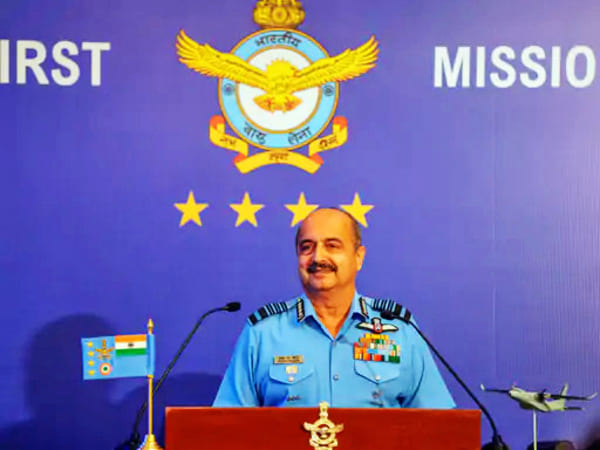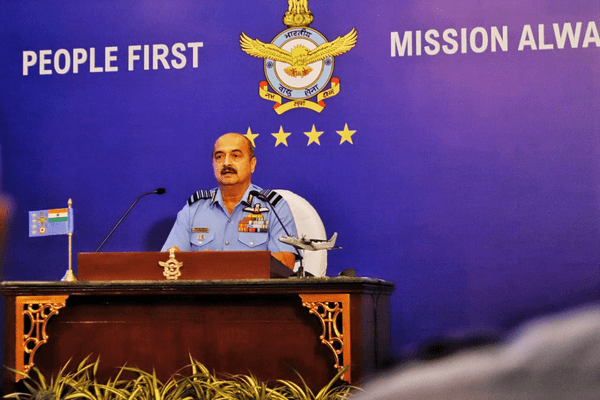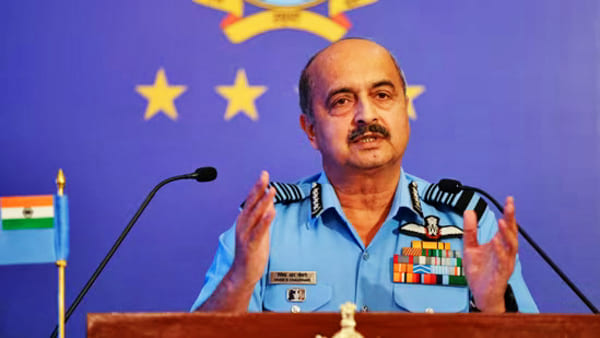
IAF Chief’s Air Force Day Press Interaction
A strong and capable military is the need of the hour, said Air Chief Marshal V R Chaudhari at the annual press conference on October 3 ahead of the Air Force Day on October 8. The Indian Air Force (IAF) will continue to remain deployed along the frontier in the region till complete disengagement takes place in the remaining contested areas in eastern Ladakh, he said.
“The IAF is constantly reassessing the evolving and dynamic situation along the Line of Control (LAC) and is monitoring it, especially in eastern Ladakh. The IAF’s operational plans are very dynamic and it will deal with challenges along the Line of Actual Control (LAC) through better tactics and training in places where it cannot counter the “numbers or the might of the adversary,” the air chief said.
Building Operational Strength
Detailing the steps being taken to bolster the Indian Air Force’s operational prowess, he said a contract to procure 97 Tejas Mark 1A aircraft at a cost of around Rs 1.15 lakh crore will be concluded soon. In February 2021, Defence Ministry sealed a Rs 48,000-crore deal with Hindustan Aeronautics Ltd to procure 83 such jets. The air chief said the IAF is looking at inducting military platforms, equipment and defence hardware worth Rs 2.5 lakh crore to Rs 3 lakh crore in the next seven-eight years.

“We have recently witnessed the induction of the first C-295 aircraft. The project is an important milestone in boosting our defence industry and will contribute immensely,” he said. He further emphasised that the key focus areas for the IAF are persistent surveillance capabilities, reducing the time from sensor to shooter, developing long-range precision weaponry, and enhancing multi-domain capabilities.
Answering a question, Air Chief Marshal Chaudhari said that the IAF received three units of S-400 missile systems from Russia and it is hoping to receive the remaining two by next year.
ALSO READ: Air Marshal VR Chaudhari, chief of Western Air Command
Acknowledging the delays in the delivery of the S-400 air defence systems from Russia due to the war in Ukraine, the Air chief said three regiments had been delivered and expressed confidence that the remaining two would be delivered next year.
Elaborating on the modernisation plans and the indigenous push, Air Chief Marshal Chaudhari said the Army and the Air Force were looking at signing a contract for 156 Light Combat Helicopter (LCH) in the coming year. Of these, 66 would be for the Air Force.
“The contract value we anticipate is ?45,000 crore. Apart from that, we had already signed a ?6,000-crore contract for 70 HTT-40 trainer aircraft. We have in the pipeline the upgrade of SU-30MKI, 84 of them; the value is anticipated to be a little over ?6,000 crore,” he said.
The weapons systems Akash-NG, medium-range surface-to-air missile (MR-SAM), air defence system Pusa, ballistic missile system Pralav, and so on are among the contracts that the IAF is expecting to sign in the coming year, he said.
The IAF Chief made it very clear that the IAF is not looking at reducing sanctioned squadron strength of 42 and that these numbers are vital for a 24×7 Combat Air Patrol. The IAF does rely purely on quantitative and qualitative analysis while reassessing the capabilities of the adversary, he said. It is important to build on the numbers of fighter squadrons since the force has a large geographical area to take care of. He mentioned that “with inductions of around six squadrons of LCA Mark 2, AMCA, and MRFA, we will be at 35 to 36 squadrons by the middle of the next decade.”
Surveillance of the Borders
The Air Chief Marshal stressed that the IAF closely monitors border situations through Intelligence, Surveillance, and Reconnaissance (ISR) methods, while addressing the issue of China’s increasing military infrastructure along the Line of Actual Control (LAC). IAF is paying close attention to the expansion of infrastructure and deployment of assets near the borders. The operational strategies of IAF are adaptable and change based on evolving circumstances, particularly along any disputed fronts.

With regards to the deployment of assets along the LAC, he said the focus of the IAF remains flexible rather than fixed. They maintain dynamic war plans that are regularly updated based on ISR data. The IAF is currently in the process of deploying mountain radars to enhance border surveillance. The IAF will deal with challenges along the Line of Actual Control through better tactics and training in places where it cannot counter the “numbers or the might of the adversary. They will remain deployed until a complete disengagement occurs in the region, the air chief added.
The Air Chief Marshal said the IAF does not have a fixed mindset in terms of the deployment of assets in key areas along the LAC.
“The situation continues to remain what it was in the last one year. There have been disengagements in certain contested areas. But complete disengagement has not yet taken place,” he said when asked about the ground situation along the LAC in eastern Ladakh.
On Chinese deployment of radars near Mansarovar, he said the Air Force was looking at inducting long-range mountain radars to “see equally deep inside the adversary’s territory”.
Noting that China and Pakistan were transferring technology, he said Pakistan was manufacturing JF-17 fighter aircraft and also inducting the J-10. “We keep an eye on the developments between these two countries.”
Impact of Current Conflicts
Responding to a question related to the impact of the Russia-Ukraine conflict on the delivery of the S-400 Missile System, the Air Chief Marshal mentioned that they have received three units so far and expressed optimism about receiving the remaining two within a year. Furthermore, he highlighted the importance of the Indo-Pacific region, describing it as the new global economic and strategic centre of gravity. The Indian Air Force’s unique capabilities, including long-range reach and precision, are essential for addressing the challenges and opportunities in this region. Given the volatile geopolitical landscape, a strong and credible military has become imperative.
The Chief of Air Staff described the Indo-Pacific region as the “new economic and strategic centre of gravity” of the world that offers both challenges and opportunities.
“The Indian Air Force with its inherent capability to see the farthest, reach the fastest and hit the hardest will be critical in mitigating these challenges and will remain a fulcrum in projecting India’s might in the region,” he said.
The IAF carried out Operation Kaveri to evacuate Indian citizens from Sudan, where it flew 22 sorties (for 115 hours), extricated 2,100 persons and carried 58 tonnes of critical load. During Operation Dost to aid Türkiye and Syria, the IAF flew 28 sorties (for 188 hours) and carried 307 tonnes of load.
New Technologies
Acknowledging the rapid evolution of modern warfare due to technological advancements, the air chief mentioned that the IAF is actively investing in technology and undergoing a planned transformation. IAF’s focus includes AI-based decision tools, electronic warfare systems, robust networks, and leveraging space and cyber capabilities.
“Our focus is on force multipliers in the form of AI (artificial intelligence)-based decision tools, electronic warfare equipment, robust networks and harnessing space and cyber capabilities. While adding newer and more potent equipment, platforms and weapons to our arsenal, we are also committed to Atmanirbhar Bharat and are contributing extensively towards enhancing indigenisation and defence production, fast-paced development and operationalisation of indigenous aerospace projects,” the Chief of Air Staff said.
ALSO READ: IAF to get new weapon systems branch – Air Chief on 90th IAF Day
Air Chief Marshal Chaudhari said persistent surveillance capability, sharpening of sensor-to-shooter time, long-range precision weapons and development of multi-domain capability are the main focus areas of the IAF.
Self-Reliance
“While adding newer and more potent equipment, platforms and weapons to our arsenal, we are also committed to Atmanirbhar Bharat and are contributing extensively towards enhancing indigenisation and defence production, fast-paced development and operationalisation of indigenous aerospace projects,” he said.
“We have recently witnessed the induction of the first C-295 aircraft. The project is an important milestone in boosting our defence industry and will contribute immensely,” he said.
IAF is working in sync with government’s push towards Atmanirbharta. The IAF Chief mentioned that India had not faced any shortage of spares, owing to the ongoing Russia-Ukraine war. “We have sourced 62,000 spares and components, locally in the last few years. Our dependence on Russia and Ukraine is reducing and we are confident that with the domestic industry stepping up, we will be able to overcome any shortfall in spares that we have been traditionally sourcing from these countries.” He added that, “our focus has been on building indigenous capabilities and also upgrading our older equipment. We are looking forward to inducting LCA Mk 1A, HTT-40 trainers, indigenous weapons and different radars. The LCH has been inducted into the Air Force yesterday and I am confident that the helicopter will add teeth to the IAF’s strike capability. We are fully committed to the development of LCA Mk 2 and AMCA. The induction of C295 aircraft is a step in the right direction and will boost the Indian aerospace manufacturing ecosystem. IAF was also the first service to sign a contract under the iDEX programme for counter-UAS systems. Mehar Baba Competition-II has also been launched and we hope to see significant progress in the domain of Unmanned Aerial Systems.”
Space Frontier IAF Chief also acknowledged the synergy with the Space based assets. He said, “we see Space as a natural extension of the air medium and we understand the need for exploiting this domain to the nation’s advantage. Space based assets significantly enhance the potency of air power and therefore our strategy is to fully integrate our Air and Space capabilities to have a common picture of the aerospace medium and to enable optimum force application.”

















